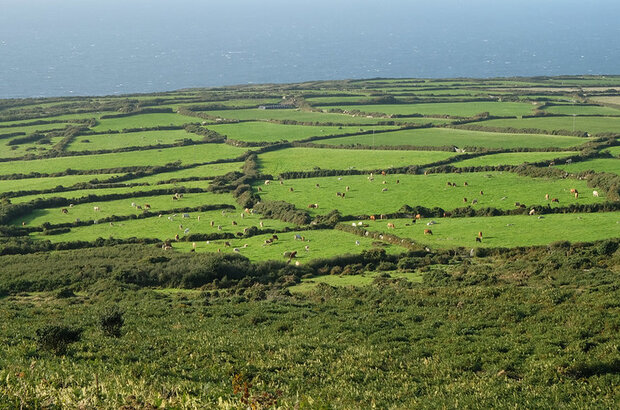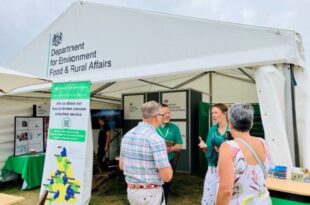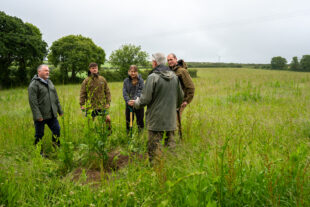
In previous blog posts we’ve written about how we’re adopting a test-and-learn approach across the Future Farming and Countryside Programme.
We’re doing this to make sure our schemes, services and policies work for users before we scale them up.
To make sure we’re on track to deliver our ambitions, we have a strategy to help us to monitor, evaluate and learn as we go.
In this blog post, I’ll share a high-level overview of the strategy and some examples of how we’re putting it into effect. But first, here’s what we mean by monitoring, evaluation and learning.
In effect, they form a cycle.
- Monitoring: this means developing and tracking metrics to help us make decisions. We track several metrics for each piece of work. These include shorter-term delivery outputs. For example, related to a specific area of land under an agri-environmental agreement. They also include medium to longer-term outcomes. For example, how our activities are contributing to the government’s 25 Year Environment Plan and Net Zero commitment.
- Evaluation: this means using evidence to determine whether outcomes were delivered and how a scheme contributed to that. Evaluation can also involve understanding the impact of processes and whether the scheme represents good value for money.
- Learning: this means taking information from monitoring and evaluation and then making recommendations and changes. We share what we’ve learned in reports on GOV.UK, here on the blog and using internal channels, in show-and-tells and other cross-programme events.
Our strategy in practice
At the start of the year, we published our environmental land management schemes outcomes. Here are some examples of how we’ve been piloting, monitoring and evaluating.
The Sustainable Farming Incentive pilot
The Sustainable Farming Incentive pilot will run until 2025. The team is delivering 2 evaluation projects which will run throughout the pilot, until 2025. Both will inform our understanding of how the pilot works in practice and help inform future scheme design and delivery decisions. It will also reveal the early-stage environmental outcomes farmers and land managers are achieving.
Tests and trials
The land management themes that we’re putting to the test with the help of farmers and land managers are:
- planning
- spatial prioritisation
- collaboration
- payments
- innovative delivery mechanisms
- advice and guidance.
Each test and trial group gathers data. Reports are published on GOV.UK and we use the findings to inform the design of our new schemes.
The first round of Landscape Recovery projects
The Landscape Recovery scheme opened for first round applications on 1 February 2022. The approach to monitoring and evaluation is likely to be undertaken across all of the projects. For example, to help understand the overall impact of Landscape Recovery, and by supporting projects to design their own monitoring and evaluation approach as an integrated part of each project.
The Natural Capital and Ecosystem Assessment
This is an England-wide programme involving several parts of Defra. Its purpose is to assess and describe the extent and condition of England’s biodiversity, ecosystems and natural capital assets. The team is assessing how environmental land management schemes could be baselined and monitored through this assessment.
The Agri-Environment Scheme Monitoring and Evaluation Programme
Many farmers and land managers are involved with Environmental Stewardship, the English Woodland Grant Scheme and Countryside Stewardship. This monitoring and evaluation programme starts with a yearly selection of projects that focus on evaluating the scheme impacts and delivery, or the factors that affect this – so physical, environmental, socio-economic or even scheme design issues.
The projects use data gathered from agreements, complemented by additional surveying work. Natural England publishes an Annual Evidence Report. We’re using the evidence from these reports to inform the design of standards for the Sustainable Farming Incentive and options for the Local Nature Recovery scheme.
If you have any questions about how we’re monitoring progress or adapting as we go, leave a comment below.




2 comments
Comment by Rachel Thompson MBE posted on
Hello
You state this ‘Reports are published on GOV.UK’ please provide an actual link, thanks
Are you monitoring the FiPL scheme? What has been learnt so far about cost and value for tax payers money with regard to the delivery of public access?
Why does Defra / GOV consistently talk in the schemes about public access as ‘permissive access’ as if the word ‘access’ cannot exist without ‘permissive’ attached? This is particularly concerning when GOV is delivering public access in perpetuity on the English Coast Path and doesn’t feel constrained in delivering best value public access when it wants to. Why is it ok for GOV a to deliver access in perpetuity but apparently doesn’t want it to feature in the agriculture schemes? Landowners should have a choice as to what mechanism they use. Please could you refer to public access as public access then make it clear what mechanisms are being offered.
Comment by The Team posted on
Hi Rachel,
We have external evaluation in place for the Farming in Protected Landscape programme, which will assess impact and value for money. As the earliest projects funded under the programme only started in the second half of last year, it’s too early to draw any conclusions on value for money at the moment.
The 25 Year Environment Plan sets out Defra’s ambition to connect more people from all backgrounds with the natural environment. Green spaces play a vital role in the nation’s wellbeing, and we’re committed to improving access and safeguarding our green spaces.
We are continuing to support and enhance access to the countryside in different ways, including supporting our network of National Trails. We intend to create a new National Trail across the North of England.
We will continue to pay for heritage, access and engagement through our existing schemes and we are considering how to maintain investment in these areas as part of future schemes.
We are looking at how our new environmental land management schemes could fund the creation of new paths, such as footpaths and bridleways, where appropriate. We are working with stakeholders and end users to determine the specific land management actions that will be paid for under our new schemes.
The link to reports on GOV.UK should work, let us know if you have any trouble accessing it.
Best wishes,
The Team